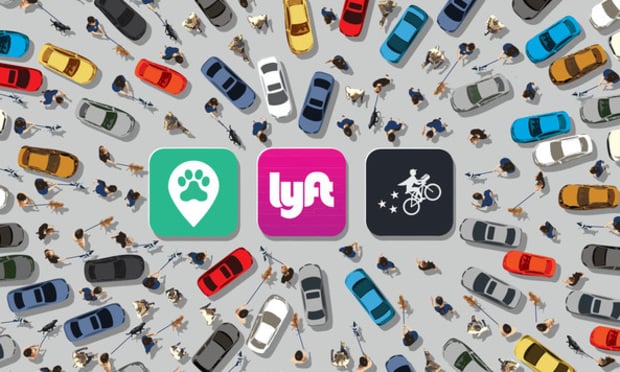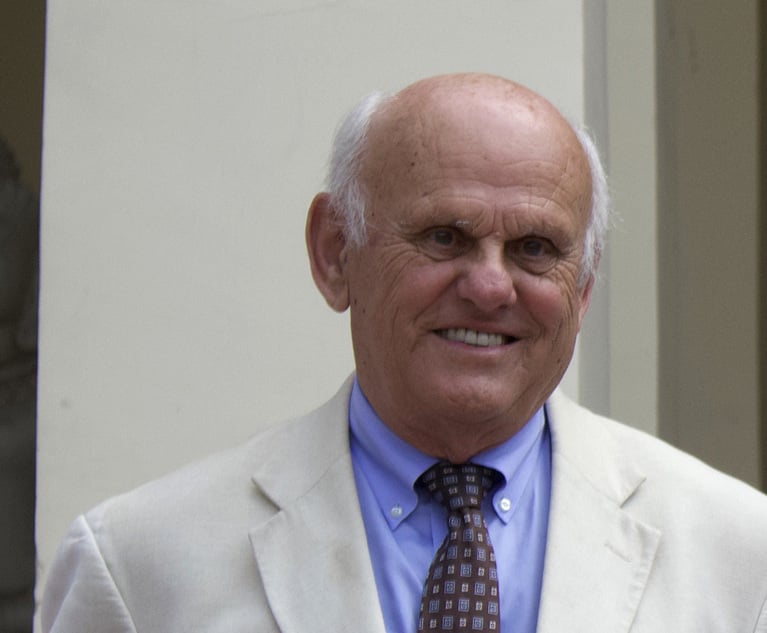Three Takeaways From the California Supreme Court's Gig Economy Ruling
Employers will "have to go back to the drawing board to determine the extent they can change their business models or work around the new test,” one attorney says.
May 01, 2018 at 07:41 PM
7 minute read

The California Supreme Court used real-world examples to explain its highly anticipated ruling that adopted a more structured test for how companies must classify their workers: A plumber who's hired to fix a problem in a retail store is an independent contractor. A cake decorator at a bakery should be considered an employee.
The ruling, with wide implications for the gig economy, put in place a new test that uses three distinct factors to determine whether a worker is an employee or an independent contractor. Monday's decision changes the standard from the more flexible one that had been used in the state since 1989.
Legal questions focused on worker classification take on special significance in a state where some of the biggest and most visible on-demand companies were founded. The business models for many app-centered companies that say they employ contractors, not employees, do not fit neatly into the categories outlined in the real-world examples explained by the court. The stakes are high—employees are entitled to certain benefits, such as minimum wage and workers' compensation.
Companies across the state are expected to re-evaluate their own workforces, and the foundation of contractor-based business models will be tested, employment attorneys told The Recorder in interviews. The number of class actions is anticipated to balloon.
The “ABC” classification test, adopted by the California court, says an independent contractor is a worker who is free from the control and direction in performing the work; the worker performs work that is outside the usual course of the business; and the worker is “customarily engaged in an independently established trade, occupation, or business” of the same nature as the work performed by the hiring entity.
What follows are three considerations that attorneys and companies are facing now.
The gig economy will have to defend its business model. And it won't be easy.
The gig economy's structure is at stake. The new test will make it more difficult for companies to defend classifying workers as independent contractors.
Two of the “ABC” factors could be problematic. The first factor of exercising control is fairly straightforward and commonly argued during litigation—companies contend their contractors are free to work as little or as much as they want. That's one of the main selling points for signing up to drive for, say, Uber or Lyft.
But the second factor—requiring that the performed work be outside the company's chief business—is trickier.
App-based companies that hire workers such as drivers or delivery personnel as independent contractors could argue they are not transportation or food delivery companies, but rather their business is technology and their product an app.
“If you are a delivery-type person and you are delivering food, would the delivery be part of the business of that entity? If you cast a critical eye to that, that type of delivery person might be an employee,” said Tim Long, a partner at Orrick, Herrington & Sutcliffe in Los Angeles.
The third factor is a puzzle, as well, and it's unclear how strictly the court will interpret the requirement that the worker has an established trade or occupation that fits the business model. Many people employed by gig companies do not consider themselves as having their own separate business entity.
“You had better look very carefully at every one of your classifications,” Long said. “This case raises heightened awareness. If you don't do it, you are taking a big chance.”
Kimberly Chase, a partner in the Orange County office of Haynes and Boone, said gig economy companies will look closely at whether they need to reclassify their workers as employees.
“Things will get more expensive and hoops to jump through in terms of how they run things,” Chase said. “It will be heavily litigated. The gig companies, such as Uber, might say, 'We are an app. We provide an app, we don't provide driving services. We never touch the food. We don't own the cars.”
Litigation is certain to increase. The interpretation of the test is still to be determined.
There has been no shortage of litigation over worker classification questions, and the sharing economy fostered even more cases and controversies. Federal and state judges around the country are being presented these issues, and the California ruling could ramp up disputes.
“There is still a lot of uncertainty,” said Zach Hutton, a Paul Hastings partner in San Francisco. “The courts will determine what it means to perform work within the usual course of business, for example. I don't think will be the end of the litigation.”
Hutton said new litigation will guide companies on the parameters of the worker classification test.
Anne Barnett, principal at Polsinelli in San Francisco and Los Angeles, said the boundaries of the “ABC” test are not clear. Companies with deeper pockets might test the waters.
“The reality is that the justices didn't use examples that are really modernized or relevant to the gig economy,” Barnett said. “Ultimately there will be an influx in litigation, particularly class actions. As a result, we'll have better boundaries of the test.”
Employers across the state will re-evaluate their workforces. Is clarity a silver lining for companies?
Long of Orrick put it like this: “What should companies be doing? Evaluating all their independent contractor classifications with critical eyes. The Supreme Court made it clear the burden is on the employer. Any responsible hiring entity should take to heart what the court is changing. They will be facing tough decisions.”
For all companies, the Supreme Court's ruling could provide certainty, said Travis Gemoets, partner at Jeffer Mangels Butler & Mitchell in Los Angeles. Gemoets said even though it's not necessarily cut and dry, the test can provide a blueprint for even gig economy companies.
“Now that this is the law of the land, businesses can say, 'Hey mine fit,'” Gemoets said. “Some of them will not and they will adjust. If they don't fit in the nice neat categories, they can re-classify or figure out a way to get them to fit.”
Hutton of Paul Hastings said companies will be looking specifically at vendor relationships. This may result in switching workers to employee status or businesses may create ways to screen these relationships moving forward to make sure they comply.
“I'm not sure there is a one-size-fits-all answer,” Hutton said. “It's certainly a stricter test with the three elements, but I don't agree that in all cases that the outcome will be determinative.”
Barnett of Polsinelli said the case will lead to “sweeping changes in how employees look at classifying their employees.” She said in California there is significant risk of wage-and-hour compliance issues.
“Employers have to go back to the drawing board to determine the extent they can change their business models or work around the new test,” she said. “It's such a significant piece of their business model. Many will not just abandon it but figure out a way to adapt.”
➤➤ Get employment law news and commentary straight to your in-box with Labor of Law, a new Law.com briefing. Learn more and sign up here.
This content has been archived. It is available through our partners, LexisNexis® and Bloomberg Law.
To view this content, please continue to their sites.
Not a Lexis Subscriber?
Subscribe Now
Not a Bloomberg Law Subscriber?
Subscribe Now
NOT FOR REPRINT
© 2025 ALM Global, LLC, All Rights Reserved. Request academic re-use from www.copyright.com. All other uses, submit a request to [email protected]. For more information visit Asset & Logo Licensing.
You Might Like
View All
'Where Were the Lawyers?' Judge Blocks Trump's Birthright Citizenship Order
3 minute read
Netflix Music Guru Becomes First GC of Startup Helping Independent Artists Monetize Catalogs
2 minute read
K&L Gates Files String of Suits Against Electronics Manufacturer's Competitors, Brightness Misrepresentations
3 minute read
Holland & Knight Hires Former Davis Wright Tremaine Managing Partner in Seattle
3 minute readTrending Stories
- 1Buchalter Hires Longtime Sheppard Mullin Real Estate Partner as Practice Chair
- 2A.I. Depositions: Court Reporters Are Watching Texas Case
- 3Second DCA Greenlights USF Class Certification on COVID-19 College Tuition Refunds
- 435 Years After CT's Affordable Housing Act, Progress Remains a Struggle
- 5Bankruptcy Judge Clears Path for Recovery in High-Profile Crypto Failure
Who Got The Work
J. Brugh Lower of Gibbons has entered an appearance for industrial equipment supplier Devco Corporation in a pending trademark infringement lawsuit. The suit, accusing the defendant of selling knock-off Graco products, was filed Dec. 18 in New Jersey District Court by Rivkin Radler on behalf of Graco Inc. and Graco Minnesota. The case, assigned to U.S. District Judge Zahid N. Quraishi, is 3:24-cv-11294, Graco Inc. et al v. Devco Corporation.
Who Got The Work
Rebecca Maller-Stein and Kent A. Yalowitz of Arnold & Porter Kaye Scholer have entered their appearances for Hanaco Venture Capital and its executives, Lior Prosor and David Frankel, in a pending securities lawsuit. The action, filed on Dec. 24 in New York Southern District Court by Zell, Aron & Co. on behalf of Goldeneye Advisors, accuses the defendants of negligently and fraudulently managing the plaintiff's $1 million investment. The case, assigned to U.S. District Judge Vernon S. Broderick, is 1:24-cv-09918, Goldeneye Advisors, LLC v. Hanaco Venture Capital, Ltd. et al.
Who Got The Work
Attorneys from A&O Shearman has stepped in as defense counsel for Toronto-Dominion Bank and other defendants in a pending securities class action. The suit, filed Dec. 11 in New York Southern District Court by Bleichmar Fonti & Auld, accuses the defendants of concealing the bank's 'pervasive' deficiencies in regards to its compliance with the Bank Secrecy Act and the quality of its anti-money laundering controls. The case, assigned to U.S. District Judge Arun Subramanian, is 1:24-cv-09445, Gonzalez v. The Toronto-Dominion Bank et al.
Who Got The Work
Crown Castle International, a Pennsylvania company providing shared communications infrastructure, has turned to Luke D. Wolf of Gordon Rees Scully Mansukhani to fend off a pending breach-of-contract lawsuit. The court action, filed Nov. 25 in Michigan Eastern District Court by Hooper Hathaway PC on behalf of The Town Residences LLC, accuses Crown Castle of failing to transfer approximately $30,000 in utility payments from T-Mobile in breach of a roof-top lease and assignment agreement. The case, assigned to U.S. District Judge Susan K. Declercq, is 2:24-cv-13131, The Town Residences LLC v. T-Mobile US, Inc. et al.
Who Got The Work
Wilfred P. Coronato and Daniel M. Schwartz of McCarter & English have stepped in as defense counsel to Electrolux Home Products Inc. in a pending product liability lawsuit. The court action, filed Nov. 26 in New York Eastern District Court by Poulos Lopiccolo PC and Nagel Rice LLP on behalf of David Stern, alleges that the defendant's refrigerators’ drawers and shelving repeatedly break and fall apart within months after purchase. The case, assigned to U.S. District Judge Joan M. Azrack, is 2:24-cv-08204, Stern v. Electrolux Home Products, Inc.
Featured Firms
Law Offices of Gary Martin Hays & Associates, P.C.
(470) 294-1674
Law Offices of Mark E. Salomone
(857) 444-6468
Smith & Hassler
(713) 739-1250






